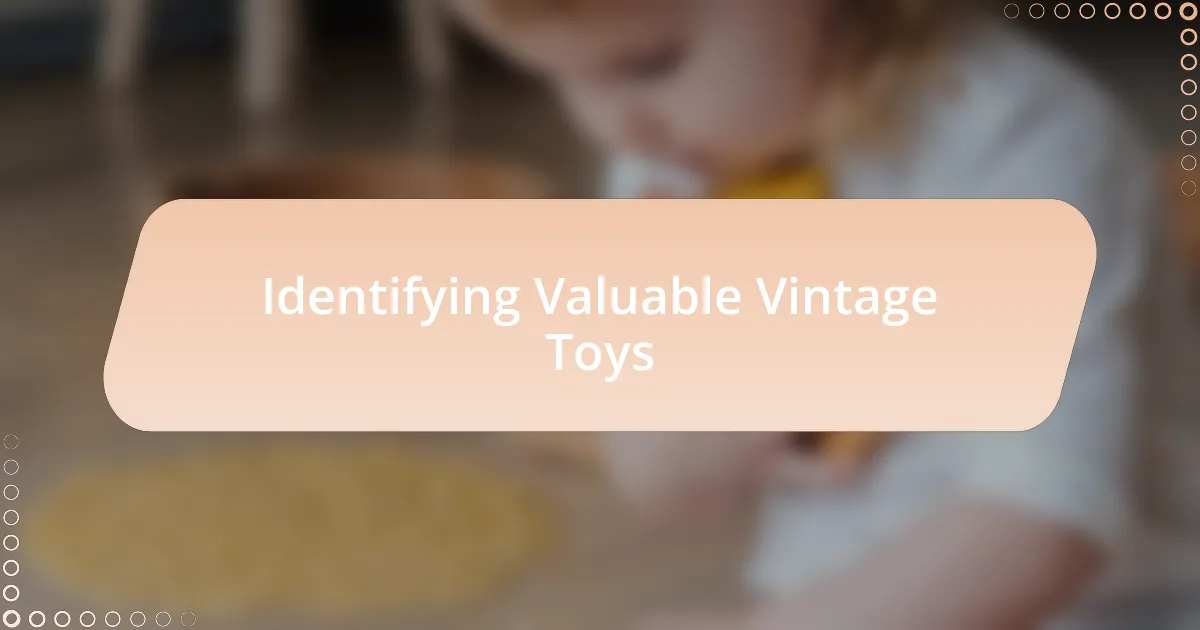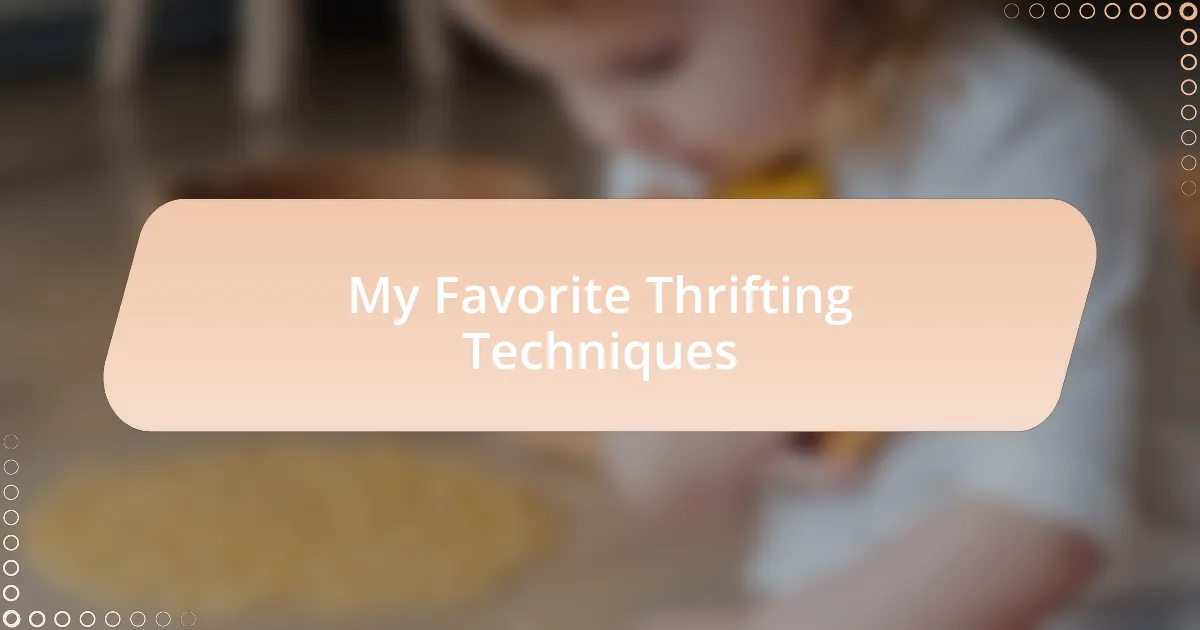Key takeaways:
- Vintage toys evoke nostalgia and reflect the cultural values of different eras, allowing connections between generations.
- Thrifting vintage toys promotes sustainability and can foster a sense of community among collectors.
- Evaluating toy condition involves checking for wear, functionality, and any unpleasant odors that may indicate damage.
- Factors like brand, rarity, and packaging significantly influence the value of vintage toys when collecting.

Understanding Vintage Toys
Understanding vintage toys goes beyond just recognizing their age; it’s about appreciating the nostalgia they evoke. I remember finding an old tin robot at a garage sale, and when I held it, I felt a rush of childhood memories, a blend of excitement and warmth. What is it about these toys that can transport us back in time?
The craftsmanship of vintage toys is truly remarkable; they often feature unique designs and materials that you just don’t see in today’s mass-produced items. When I first laid eyes on a wooden train set, I marveled at the intricate details and the smoothness of the wood. Doesn’t it make you wonder how many children before us played with those very pieces, creating their own imaginative worlds?
Moreover, vintage toys often tell stories of their time, reflecting the cultural values and interests of different eras. I recall flipping through an old toy catalog from the 1960s, and it highlighted not just toys but the dreams and aspirations of a generation. Isn’t it fascinating to think about how a simple toy can connect the past and present, bridging gaps between generations?

Importance of Thrifting Toys
Finding vintage toys through thrifting is not just about saving money; it’s also about discovering unique pieces that have their own history. I remember sifting through a dusty box at a thrift store, only to uncover a rare action figure that had clearly been well-loved. That moment reminded me of the joy in collecting items that carry stories, allowing us to hold a piece of nostalgia in our hands. Don’t you think it’s amazing how each toy has the potential to spark cherished memories?
Thrifting toys promotes sustainability, which is essential in today’s consumer-driven world. Every vintage toy purchased is one less item added to a landfill, and I often marvel at how these little treasures continue to have value despite their age. Isn’t it heartening to think that buying a toy second-hand can contribute to reducing our environmental impact while preserving history?
Moreover, thrifting encourages a sense of community and connection with others who share similar interests. I vividly remember striking up a conversation with a fellow collector at a flea market, bonding over our favorite childhood toys. Does this not make you feel part of something larger? Each toy not only brings joy to our own lives but can also act as a catalyst for friendships and storytelling, making the thrifting experience truly special.

Tips for Evaluating Toy Condition
When inspecting vintage toys, the first thing I do is check for any visible wear and tear. Scratches, missing pieces, or discolored paint can significantly affect a toy’s value and collectibility. I recall finding a beautifully crafted doll once, but her missing shoe turned out to be a dealbreaker for me. Isn’t it fascinating how something seemingly small can dramatically impact our perception of a toy’s worth?
Next, I focus on functionality, especially for toys that require batteries or mechanical components. I always ask myself, “Does it work?” and if possible, test it right there in the store. I remember the excitement of reviving an old remote-controlled car that wheeled into action on its first try. That moment not only confirmed I had a gem but also made me imagine the fun it had brought to its previous owner.
Lastly, I’m mindful of the toy’s smell and any signs of mold or damage. A musty odor can be a red flag, suggesting long-term storage issues. I once discovered a vintage playset that had an unpleasant smell; it reminded me of my grandmother’s attic. While it was tempting, I ultimately decided to pass on it. Have you ever walked away from a find that just didn’t feel right? It’s all part of the evaluating process.

Identifying Valuable Vintage Toys
When I’m on the hunt for valuable vintage toys, the brand often plays a crucial role. Well-known manufacturers like Mattel or Hasbro have a dedicated following, and knowing their sought-after lines can give me an upper hand. I remember tracking down a rare Fisher-Price toy that had been on my wish list for years. The thrill of finally finding it in a thrift store brought back memories of my childhood, as I eagerly scrutinized the details for authenticity.
Another factor I consider is the toy’s rarity. Limited editions or those with a short production run can be highly collectible. Just the other week, I stumbled upon a boxed set of action figures from a beloved franchise. The excitement was palpable as I recalled how hard some of my friends had searched for them! It was a stark reminder that sometimes, the hunt is as rewarding as the find itself. How often do we overlook the stories behind the toys we cherish?
Lastly, the packaging can dramatically influence a toy’s value. Original boxes, especially if they include unique artwork or promotional materials, are more than just containers; they tell a story. I once found a vintage puzzle still sealed in its original box, and you can imagine my thrill! It felt like holding a piece of history. Does that element of nostalgia resonate with you when you’re thrift shopping? Every vintage toy holds memories waiting to be discovered.

My Favorite Thrifting Techniques
I love to dive into thrift stores early in the morning when they first open. The thrill of being among the first to sift through the shelves is invigorating. One time, I found a dusty box of LEGO bricks just as they were setting everything out. It felt like I had stumbled onto buried treasure, and I couldn’t help but wonder what kinds of adventures those pieces had already been a part of!
Another technique I swear by is getting familiar with certain thrift store layouts. I’ve noticed that some places tend to group toys in particular sections, while others stash them next to home goods or clothing. Once, I discovered an impressive collection of vintage dolls stacked next to kitchenware. It made me realize how easy it is to overlook potential gems if I don’t keep my eyes open. Have you ever found something surprising in an unexpected spot?
Lastly, I always keep a keen eye on condition and completeness. For instance, I once found a vintage playset minus a few figures. While it wasn’t fully intact, I felt a sense of excitement thinking about sourcing the missing pieces later. That’s part of the joy of thrifting, isn’t it? The idea of bringing a toy back to its former glory adds a personal touch to every find. How rewarding is it to restore something cherished?